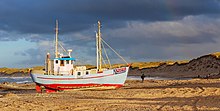Fishing industry in Denmark
This method of fishing spread to Esbjerg on the south-west Jutland coast in 1880 when transportation using rail links facilitated export to Europe.
Esbjerg became a popular site for all Danes for fishing plaice in early 1900 when motorized boats were also introduced for the operations.
[4] In 1903, the fishery limit for the Faroe Islands was 3 nautical-miles under an agreement signed between Denmark and Great Britain.
In terms of financial value, the fish species of interest, in the order of precedence, are cod, sand eel, plaice, herring and Norway lobster.
One feature which needs consolidation is the uniting of small fishing operators of Denmark into one viable major sector, as at present the Norwegians have held this position.
As the Danish industrial and cod fisheries role is a major factor in the North Sea, the resource position of a few species is not definite.
One feature which needs consolidation is the uniting of small fishing operators of Denmark into one viable major actor, as at present the Norwegians have held this position.
[9] Democratic values are practiced in the fishing with trawlers, as the fleet involved with the operations shares the catch value equally among all the members of the ship, which is an incentive to every fisherman to bring in more catch[3] There are prescribed rules and quotas for purchase of fishing vessels.
Fishing volume in one pelagic vessel is restricted to a maximum of 10% of the Danish herring in the North Sea.
By contrast, industrial fishing prospered with a price rise of 34% which, despite lower catches, brought an increase in profits of 31%.
Individual owners are also permitted to have higher fishing rights, and it is in consonance with the policy followed for pelagic and industrial fisheries.
[15] National legislation in fishing has been adopted with due quota allocations done under the EU policy with technical rules that are framed on the basis of scientific studies which are carried out regularly.
[7] Another policy aspect is that according to biologists the number of fishermen in the field are quite large and the resources available may not be adequate to sustain all of them to be at par with the national average income level and this would call for greater efficiency of operations with less of wastage.
[1] Aquaculture in freshwater ponds and in salt water marshes are also finding increased attention of the government by breeding more species.
[1] Since 2004 new rules are in force for freshwater and saltwater fishing as an aquaculture practice under specific organic labeling.
Freshwater fishing in ponds is notable for rainbow trout (Oncorhynchus mykiss); this species is also adopted to land-based marine aquaculture.
[15] Environmental issues such as pollution from agricultural land flows with high nutrients have choked the fjords, which are causing the death of fish due to lack of oxygen.






